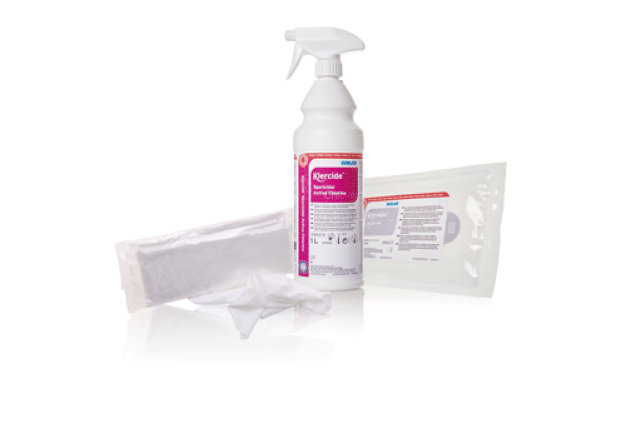- Clothing & Consumables
Recognizing risks and reducing exposure to cytotoxic drugs
James Tucker marketing director at Ecolab Contamination Control explains the dangers of exposure to cytotoxic drugs among operators and how his organisation is taking specific steps to reduce this through product development.
Occupational exposure to cytotoxics is a serious issue within the pharmaceutical and compounding industry and is likely to occur when control measures are limited. The types of activities which put operators, pharmacists and laboratory staff at most risk are drug preparation and cleaning up residues and spills.
One of the key challenges posed by cytotoxics is that as well as being difficult to remove from surfaces and equipment they can continue to present a risk directly as waste. It is therefore essential that the right procedures and products are implemented to ensure contamination is kept to an absolute minimum.
Under the Health & Safety Executive Control of Substances Hazardous to Health regulations (COSHH), there needs to be comprehensive assessments of the risks arising from handling cytotoxic drugs at every stage of use and disposal.
Control and monitoring of the effects of exposure has been studied in detail with a range of biological endpoints including DNA damage, HPRT mutations and thioether excretion, among others, which highlight the seriousness of this issue.
Analytical methods are also now being employed to measure the level of environmental contamination in the workplace, and numerous studies have been published on environmental wipe sampling for these drugs as the issue becomes more widely known.
Similarly, the data collection and actions to identify and remedy exposure levels of cytotoxic drugs is definitely on the increase.
Two key agencies responsible for conducting research and making recommendations, the National Institute for Occupational Safety and Health (NIOSH) and the Institution for Statutory Accident Insurance and Prevention in the Health and Welfare Services (BGW), have both taken steps to raise awareness on the subject.
NISOH has published an alert; ‘Preventing Occupational Exposure to Antineoplastic’, whilst BGW has conducted a study in Germany, ‘Monitoring-Effect for Wipe Sampling in Pharmacies’ (MEWIP), in which cytotoxic drugs were found on 61 per cent of all wipes used in three sampling positions within pharmaceutical cleanrooms; worktop, floor and fridge. Contamination levels of over 70 per cent, 60 per cent and 50 per cent respectively were observed. This has led to the implementation of a reference value of 0.1ng/cm sq. for pharmaceutical cleanrooms in Germany, Switzerland, Austria and Poland dealing with cytotoxic drugs.
The elimination of cytotoxic drugs on surfaces, often caused by spillages, should be a major priority for the industry. One definite way to achieve this is through the controlled use of Ecolab Contamination Control products which have been manufactured in a cleanroom environment, with a proven and tested capability in their safe removal and destruction.
The independent work performed by Institute of Energy and Environmental Technology (IUTA) recommends a combined procedure of spraying a Klerwipe polyester dry wipe with Klercide Sporicidal Active Chlorine spray. Following a contact time of 5 minutes, the surface should then be wiped with Klerwipe 70/30 IPA impregnated wipes. This combination is proven to have optimum efficacy in the removal of a full range of cytotoxic compounds from surfaces, eliminating up to 99.9 per cent of them.*
Other measures as part of a robust operational best practice procedure to minimise exposure include the safe handling, storage and transport of cytotoxic drugs and waste material containing or contaminated by them, along with effective disposal.
These are in addition to using totally enclosed systems where practical, controlling exposure at source by using adequate extraction systems and providing staff with the necessary protective equipment.
Mr Tucker concludes: ‘Ecolab Contamination Control has developed a range of products that are scientifically proven to reduce the risks associated with cytotoxics. Uniquely they both remove and denature the cytotoxic residues when used in combination, making disposal safer and ensuring contamination control right along the waste removal journey.
‘We fully expect other national pharmaceutical industries to follow the lead of those European countries that have already introduced specific legislation on this important subject, but it still remains to be seen. Regardless of this it should not deter responsible employers from taking the initiative and adopting their own proactive approach.’
* For further information on the test work carried out please contact Ecolab Contamination Control for technical report TR1502R. The trial was conducted using Ecolab’s Klercide and Klerwipe products; data is not transferable to similar products.
![]()
ECOLAB LIFE SCIENCES
Winnington Avenue
CW8 4DX Northwich, Cheshire
United Kingdom
Phone: +44 1606 721999
email: infoLS@ecolab.com
Internet: https://www.ecolablifesciences.com









